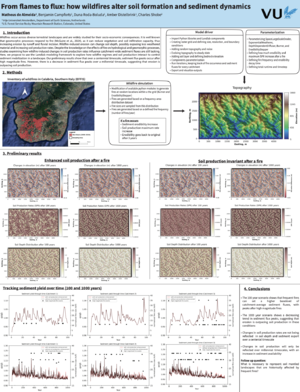2025 CSDMS meeting-037
From CSDMS
(if you haven't already)
Log in (or create account for non-CSDMS members)
Forgot username? Search or email:CSDMSweb@colorado.edu
Browse abstracts
From flames to flux: how wildfires alter soil formation and sediment dynamics
Matheus Wanderley de Almeida,
(he/him),Vrije Universiteit Amsterdam Amsterdam , Netherlands. m.wanderleydealmeida@vu.nl
Benjamin Campforts, Vrije Universiteit Amsterdam , Netherlands. b.campforts@vu.nl
Duna Roda-Boluda, Vrije Universiteit Amsterdam , Netherlands. d.c.rodaboluda@vu.nl
Amber Distelbrink, Vrije Universiteit Amsterdam , Netherlands. a.distelbrink@vu.nl
Charles Shobe, U.S. Forest Service Rocky Mountain Research Station Fort Collins Colorado , United States. charles.shobe@usda.gov
Wildfires occur across diverse terrestrial landscapes and are widely studied for their socio-economic consequences. However, their role in triggering erosion and controlling sediment dynamics is less well understood. Wildfires reduce canopy and ground cover, disrupting soil infiltration capacity, thus increasing erosion by runoff and channel incision. Wildfire-induced erosion can change soil depth, possibly exposing less weathered material and increasing soil production rates. Despite extensive research into the effects of fire on hydrological and geomorphic processes, studies examining how wildfire-induced changes in soil production rates influence catchment-wide sediment fluxes are still lacking. Here, we propose to use the Landlab modeling framework to explore how wildfire regimes and soil production interact to control sediment mobilization in a landscape. Pulses of sediment can be triggered after a single fire, however, in areas with frequent wildfires, sediment supply may be limited by soil production, controlling the transition from soil-mantled to bedrock landscapes. We investigate how different wildfire regimes influence sediment production and transport over decadal to millennial timescales. We expect our modeling results to help quantify how soil production rates respond to different wildfire regimes, shaping sediment dynamics and ultimately controlling overall soil thickness.

